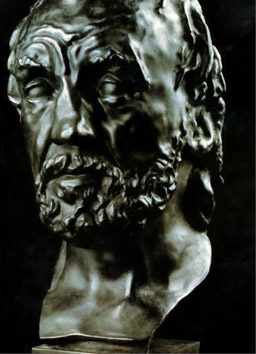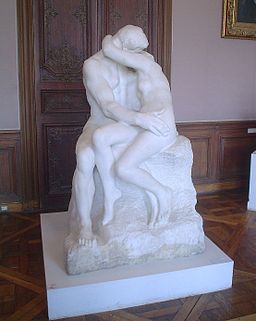The display, which will be in place until August this year, is celebrating the centenary of Rodin’s visit to Cheltenham when he left France at the start of the Great War with his biographer Judith Cladel. Visiting with Cladel’s sister gave Rodin the opportunity to visit the Cheltenham Art Gallery & Museum where later in 1933; “The Kiss” would go on display for the first time.
About Auguste Rodin
Early Years
Auguste Rodin was born in a poor part of Paris in the Rue de l’Arbalete on the 12th November 1840. He is revered as one of the most significant sculptors of the times. His legacy has given the world such iconic works such as “The Kiss” and “The Thinker” possibly some of the most well-known pieces of sculpture to emerge in modern times.

At the age of 14 years, Rodin persuaded his father to allow him to attend the “Petite Ecole” where he was taught by painter Horace Lecoq de Boisbaudran. The four years spent at the school were an essential part of his art training. He learnt to develop powers of observation and traditional art techniques. He won a medal for his drawing work and joined the class in sculpture, spending time at the Louvre. Rodin applied to the Ecole des Beaux-Arts in order to study sculpture but to his dismay he failed the entrance examination three times. In order to contribute to his family finances, he commenced work with many different decorative artists and met the sculptor Jules Dalou who he made a bust of to celebrate Dalou’s Salon award. Rodin sculpted his father as a Roman senator during this time.
Relationship
Deeply affected by the death of his sister Maria, Rodin entered a monastery as a novice known as Brother Auguste. He sculpted a bust of the founder, the Father Pierre-Julian Eymard. As time passed Rodin took animal anatomy classes and in 1864 met Rose Beuret who was to be his muse and lifelong companion. In 1865 Rodin presented a work entitled “The Man with the Broken Nose” to the Salon which was promptly rejected. The following year saw the birth of Rodin’s illegitimate son Auguste-Eugène Beuret who would later become an engraver and draughtsman. Rodin was inspired by his son and produced many studies depicting infants and children.

A brief foray into the Garde Nationale saw Rodin become a corporal only to be discharged because he was near sighted.
From 1874 Rodin worked on many ornamental projects for buildings such as the Palais des Académies, Brussels. He also continued painting and produced many landscapes from the forest of Soignes where he often walked with Rose. Rodin began to exhibit works in the Paris Salon and also travelled to Italy to study Michelangelo and other Renaissance artists. He was inspired and produced “The Age of Bronze” which alludes to the ages of man depicted by Greek poet Hesiod.
Later Years

Tiring of Paris and his official and social obligations, Rodin purchased a villa in Meudon from where he commuted to his studio. He built up his own collection of art work and antiques purchased from auctions, dealers and private collections. He received commissions on a regular basis and exhibited his work outside of France. By 1900 Rodin was appointed Knight of the Order of Leopold of Belgium.
Further accolades were bestowed including Commander of the Legion of Honour, honorary doctorates from the University of Jena, University of Glasgow and Oxford University.

Towards the end of his life Rodin fled the war in 1914 and moved to England before moving on to Rome where he enjoyed a leisurely lifestyle and rediscovered the beauty of Rome and spent much time sketching. He also visited Pope Benedict XV as he was commissioned to sculpt a portrait bust of the pope.
Following a stroke Rodin fell gravely ill and he offered his works to the nation of France and the Hotel Biron that had been important to him during his life and was converted into a Rodin museum. He also married his lifelong companion Rose Beuret despite his many affairs throughout the relationship. She died two weeks after the marriage on St. Valentine’s Day. Rodin died in the same year in November and was laid to rest beside Rose at Meudon. A large cast of “The Thinker” adorns their grave.

